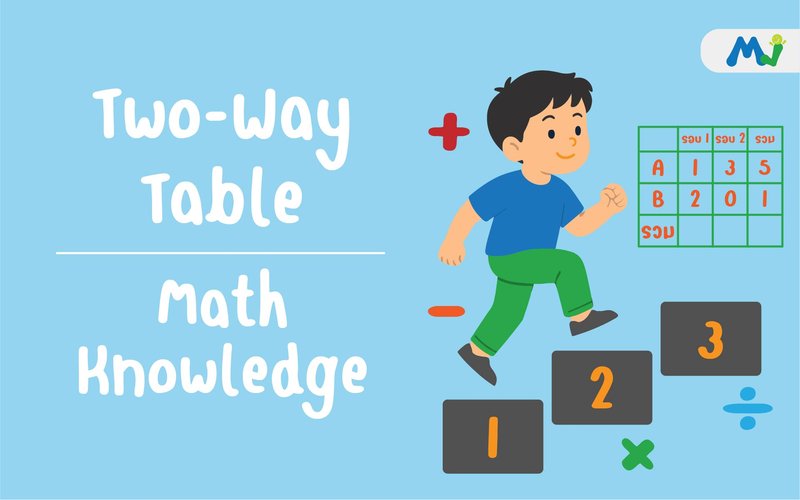


Two-Way Tables are tables that organize data into rows and columns, helping us clearly see the relationship between two sets of information. They are especially useful when managing large or complex data. Two-way tables are an important foundation in elementary math learning and elementary math tutoring, and they are widely used in everyday life.
A survey of sports preferences in a classroom of 20 students, divided by Gender (Boy–Girl) and Favorite Sport (Soccer, Volleyball, Badminton), produced the following results:
| Gender | Soccer | Volleyball | Badminton | Total |
|---|---|---|---|---|
| Boy | 6 | 2 | 2 | 10 |
| Girl | 1 | 5 | 4 | 10 |
| Total | 7 | 7 | 6 | 20 |
Find the number of boys who like soccer.
| Gender | Soccer | Volleyball | Badminton | Total |
|---|---|---|---|---|
| Boy | 6 | 2 | 2 | 10 |
| Girl | 1 | 5 | 4 | 10 |
| Total | 7 | 7 | 6 | 20 |
Row "Boy" with column "Soccer" = 6 → There are 6 boys who like soccer.
Find the number of girls who like badminton.
| Gender | Soccer | Volleyball | Badminton | Total |
|---|---|---|---|---|
| Boy | 6 | 2 | 2 | 10 |
| Girl | 1 | 5 | 4 | 10 |
| Total | 7 | 7 | 6 | 20 |
Row "Girl" with column "Badminton" = 4 → There are 4 girls who like badminton.
Find the total number of boys.
| Gender | Soccer | Volleyball | Badminton | Total |
|---|---|---|---|---|
| Boy | 6 | 2 | 2 | 10 |
| Girl | 1 | 5 | 4 | 10 |
| Total | 7 | 7 | 6 | 20 |
Row "Boy" in the "Total" column = 10 → There are 10 boy in total.
Sometimes a table may not include the "Total" column directly, but we can calculate it by adding up the numbers in that row. For this example: $6 + 2 + 2 = 10$
Find the total number of students who like volleyball.
| Gender | Soccer | Volleyball | Badminton | Total |
|---|---|---|---|---|
| Boy | 6 | 2 | 2 | 10 |
| Girl | 1 | 5 | 4 | 10 |
| Total | 7 | 7 | 6 | 20 |
Row "Total" in the "Volleyball" column = 7 → There are 7 students who like volleyball in total.
If the table does not include a total row, we can calculate the column sum ourselves. For this case: $2 + 5 = 7$
Find the total number of students.
| Gender | Soccer | Volleyball | Badminton | Total |
|---|---|---|---|---|
| Boy | 6 | 2 | 2 | 10 |
| Girl | 1 | 5 | 4 | 10 |
| Total | 7 | 7 | 6 | 20 |
Row "Total" in the "Total" column = 20 → There are 20 students in total.
If the table does not include a total row, we can calculate totals ourselves. For this case: $7 + 7 + 6 =10+10 = 20$ or by adding every number in the table: $6+2+2+1+5+4=20$
A survey of 25 students divided by urban and suburban areas, and by type of pet (cat, dog, fish) produced the following two-way table:
| Area | Cat | Dog | Fish | Total |
|---|---|---|---|---|
| Urban | 5 | 4 | 3 | 12 |
| Suburban | 3 | 5 | 5 | 13 |
| Total | 8 | 9 | 8 | 25 |
💡 Once children understand two-way tables, they will gain sharper skills in data management and analysis, useful both in the classroom and everyday life.
Two-way tables are powerful tools that simplify complex data. Students who learn to read and use them will build analytical skills and be better prepared for elementary math learning and advanced mathematics. They can also apply these skills to daily life, such as recording activities or organizing information systematically.
At MJ, we provide free elementary math articles that are clear and easy to understand. And for parents who want their children to practice with real problems, MJ’s online elementary math tutoring and one-on-one math lessons with experienced elementary math teachers will help children enjoy learning and truly improve 🚀
Explore P.5 Term 1 Math Curriculum with essential concepts, advanced lessons, and problem-solving strategies to build confidence and mastery in math.